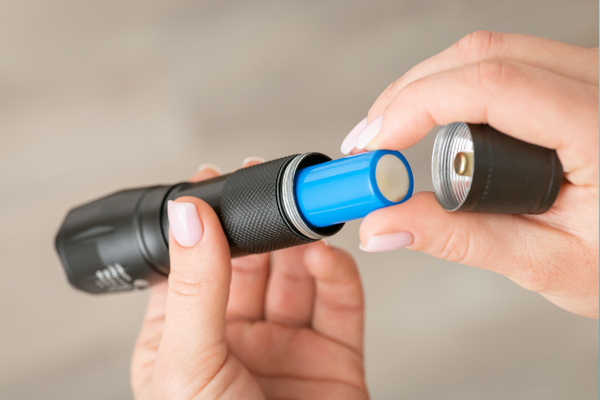Key Highlights
- 26650 batteries are bigger and heavier than 18650 batteries. A 26650 battery is 26mm wide. A 18650 battery is 18mm wide.
- A 26650 battery is bigger but has less energy density than a 18650 battery. Still, it can hold more energy overall.
- 26650 batteries are used in things that need a lot of power, such as power tools and electric vehicles. 18650 batteries are usually used in portable electronics.
- When you pick one of these batteries, consider what your device needs. Consider how much space you have and how much it will cost.
- You should read the battery specifications and safety tips every time before you use them.

Introduction
Lithium batteries are important for daily use, powering electric vehicles and portable electronics. Many people prefer reusable and efficient energy sources, making it essential to understand different types of lithium batteries. This guide discusses the features, uses, and differences between two common lithium-ion batteries: the 26650 and 18650.
Importance of Battery Sizes and Types in Electronics

Choosing the right battery type is crucial for device performance and longevity. Using the correct battery in smartphones, laptops, and power banks keeps the gadgets safe and ensures they receive adequate power.
Using the wrong battery can harm your device and pose safety risks. A battery with insufficient power may lead to rapid depletion, requiring frequent recharging.
Check the device’s specifications before purchasing a new battery. Ensure you’re using the correct battery type and size. Knowing the differences between battery types like 26650 and 18650 helps you select the right batteries. This is also beneficial for creating your own battery packs.
Key Features and Applications of 26650 Batteries
26650 batteries can keep more energy than 18650 batteries. These batteries are bigger. That lets them give more power for many things. You can use them for energy storage, power tools, and electric vehicles. There are other uses too. These batteries also go into portable electronics, medical equipment, and power banks.
|
Key Features |
Description |
|---|---|
|
High Capacity |
1500–3600mAh, supports long runtime for devices. |
|
Long Cycle Life |
300–1000+ charge cycles, durable and cost-effective. |
|
Stable Voltage |
Nominal 3.6–3.7V, ensures consistent performance. |
|
High Discharge Rate |
Up to 30A, suitable for high-drain applications. |
|
Safety Features |
Protected cells include overcharge, over-discharge, and short-circuit protection. |
|
Compact Size |
18mm x 65mm, fits various portable devices. |
The 18650 battery gives you a lot of power and works for a long time. It has a long cycle life and keeps the voltage steady. It is also made with strong safety features. This makes it a good choice for small, high-performance devices.

|
Applications |
Description |
|---|---|
|
Flashlights |
Powers high-lumen LEDs for bright, long-lasting light. |
|
Power Tools |
Drives cordless drills, saws, and other high-power tools. |
|
Electric Vehicles |
Used in e-bikes and Tesla battery packs for reliable energy. |
|
Vaping Devices |
Provides high discharge for consistent vape mod performance. |
|
Laptops |
Powers portable computing with long-lasting energy. |
|
Energy Storage |
Stores solar/wind energy for efficient power management. |
The 18650 battery is a good choice because it has high energy density and a strong discharge rate. It can be used for many things, including flashlights, power tools, electric cars, vaping devices, laptops, and even energy storage from renewable sources. That is why many people like to use it for different tasks. It works well for all these needs.
Key Features and Applications of 18650 Batteries
The 26650 battery has a high capacity and a long life. It provides a stable voltage while also having strong safety features. This makes it a good and eco-friendly choice for tough jobs requiring a lot of power.
|
Key Features |
Details |
|---|---|
|
High Capacity |
4000–6000mAh, enables extended device runtime |
|
Long Lifespan |
500–2000 charge cycles with proper maintenance |
|
Stable Voltage |
3.2–3.7V nominal, consistent power output |
|
High Discharge Rate |
Up to 30–60A, ideal for high-drain devices |
|
Safety Features |
Overcharge, over-discharge, short-circuit protection |
|
Eco-Friendly |
Rechargeable, no toxic metals |
Applications
The 26650 battery is used in many different things because it is strong and reliable. It is found in power tools, electric vehicles, and medical equipment. It helps these devices work well and keeps them running when needed most, making it a good choice for many uses.

|
Applications |
Examples |
|---|---|
|
High-Performance Flashlights |
Outdoor, tactical, camping lights |
|
Power Tools |
Cordless drills, saws |
|
Electric Vehicles |
E-bikes, EV battery packs |
|
Vape Devices |
High-wattage vape mods |
|
Medical Devices |
Portable ventilators, defibrillators |
|
Energy Storage |
Solar, wind, UPS backup systems |
Key Difference Between 26650 and 18650 Battery
Both 26650 and 18650 batteries have lithium-ion inside. The main difference is the size of the batteries. The 26650 battery is bigger than the 18650. Because of this, it can store more energy, which makes it good for other things.
It is important to know the differences. The right choice lets you get the best battery for your needs. In the text below, we will discuss how these two common batteries work and what features they have. This can help you choose smartly.
Specification Comparison
|
Specification |
26650 Battery |
18650 Battery |
|
Diameter |
26 mm |
18 mm |
|
Length |
65 mm |
65 mm |
|
Nominal Voltage |
3.6V – 3.7V |
3.6V – 3.7V |
|
Capacity Range |
2500mAh – 5500mAh |
1200mAh – 3600mAh |
|
Typical Capacity |
~4000mAh – 5000mAh |
~1800mAh – 3500mAh |
|
Max Discharge Current |
Up to ~11A (continuous), ~27A (short pulse) |
Up to ~20A (continuous) |
|
Weight |
~90g – 94g |
~45g – 50g |
|
Energy Density |
~211 Wh/kg |
Moderate energy density |
|
Common Uses |
Power tools, electric vehicles, solar storage systems, high-drain devices |
Laptops, flashlights, vapes, power banks, portable electronics |
In Summary:
- 18650 batteries are small and easy to use. They are good for portable electronics like laptops and flashlights.
- 26650 batteries have higher capacity and give more power. These are best for power tools and e-bikes that need a lot of energy.
- You should choose 18650 if you need something light for a device with little space. Go with the 26650 battery when you want longer use and need high power.
Pros and Cons of 18650 and 26650 Batteries
When you pick between 18650 and 26650 batteries, you need to look at the good and bad parts of each. This can help you find the right battery for what you need. Both of these battery types work well for different things. But, knowing their downsides can help you avoid fitting problems and safety concerns.
Here, we will talk about the good and bad things of each battery type. This will help you know which one is the best for your needs.
Pros and Cons of 18650 Battery

18650 batteries are used extensively in consumer electronics. Many people like these batteries because they are small and have high energy density. This means they can hold much power in a small space, making them a good fit for portable devices. These devices need much power but should not take up much room.
Another good thing about 18650 batteries is that they are easy to find and do not cost much money. Their construction makes them reliable. But because of their smaller size, they might not be the best choice for times when you need a lot of power over a long time.
18650 batteries are a good choice for many things. You can find them in laptops and flashlights. People also use them in power banks. These batteries are now being used more in electric vehicles. They also work well in energy storage systems.
Pros and Cons of 26650 Battery

The best thing about 26650 batteries is their larger size. They can keep more energy than 18650 batteries, so they work well for electric vehicles and tools. These things need strong and long-lasting power.
26650 batteries last longer than 18650 batteries. They can also go through more charge cycles. However, their larger size makes it hard to fit them into small spaces.
26650 batteries are great when you need a lot of power. They are used the most in energy storage, electric vehicles, and renewable energy systems. Because of their strong power and long life, they work well in all these areas.
In Summary:
- 18650 batteries are small and cost less. They are great to use in portable electronics.
- 26650 batteries work well in things that need much power and run for a long time. Power tools are a good example.
- Go for 18650 if you have a small and light device. Choose 26650 if you need lots of power or to run equipment a long time.
Tips For Choosing High-Quality 18650 and 26650 Cells

- Verify Certifications: Make sure you pick cells that have the right certificates like IEC, CE, MSDS, UN38.3, and UL. Pkcell Battery follows these rules to be safe, so you get good 18650 and 26650 cells.
- Assess Manufacturing Quality: Look for suppliers that excel at both making and testing batteries. Pkcell Battery uses careful assembly, so its cells last a long time and have a lot of power.
- Match Application Needs: Choose cells that fit one use, like high-drain electronics, electric vehicles, or vaping. Pkcell Battery has 18650 and 26650 cells built for steady power and strong performance.
- Ensure Supply Reliability: Stick with suppliers who can support you with small order amounts and fast delivery worldwide. Pkcell Battery gives quick, on-time shipping, choices in order size, and even free samples.
Pick Pkcell Battery when you want top 18650 or 26650 cells. You can ask for a free quote today!
Conclusion
Knowing the differences between 26650 and 18650 battery type is important. This will help you pick the best power for your devices. Each battery type has its good points and uses. You should think about what your device needs and how much power it will use. You can look at their features and decide which is right for you. Always be careful when you handle batteries and follow all safety steps. If you need extra help or want to get battery quotes, feel free to contact us. Picking the right battery type will make your devices work better and last longer.
Why Choose Pkcell?
Pkcell began in 1998. It is one of the top battery makers in China. The company is known for good and new power solutions. Their factory is very big, about 28,000 square meters. A team of more than 50 people works on research and development at this place. They sell good batteries to customers in over 100 countries.
We have many kinds of batteries for you. You can get alkaline, carbon-zinc, button cells, Li-SOCl2, Li-MnO2, and rechargeable NiMH or NiCd batteries. We also sell lithium-ion batteries and battery packs. These batteries are used in several areas. They help in security, medical devices, smart homes, and consumer electronics. Get a quick quote now!

Frequently Asked Questions
Can I use a 26650 battery in a device designed for 18650?
Do not use a 26650 battery in a device made for 18650 batteries. A 26650 battery is bigger, so it may not fit in or work the way it should, which can cause safety risks. Always look at the device’s specifications and guidelines for proper handling. This will help you make sure everything works together safely.
What are the safety tips for handling 26650 and 18650 batteries?
- Always use the right charger that matches your battery type.
- Do not use batteries from different brands or sizes together.
- Never let lithium-iron phosphate batteries get too hot, too cold, or wet.
- Proper battery handling can help lower the chance of short circuits or fires and keep you safe.
How long do 26650 and 18650 batteries typically last?
The cycle life of 26650 and 18650 batteries is around 300 to 500 charging and discharging cycles. You can use them several times before they lose power. But how you use them, the temperature, and how you charge them can change the battery life.
Are 26650 batteries more expensive than 18650 batteries?
In most cases, 26650 batteries cost more than 18650 batteries. This is due to their larger capacity and the fact that they use more materials to make. However, the price you pay can go up or down depending on the brand, the quality of the battery, and the number of people who want it. It is always good to choose trusted brands. A good brand helps to keep you safe and also makes things work better.

 USB Rechargeable Lithium Battery
USB Rechargeable Lithium Battery





